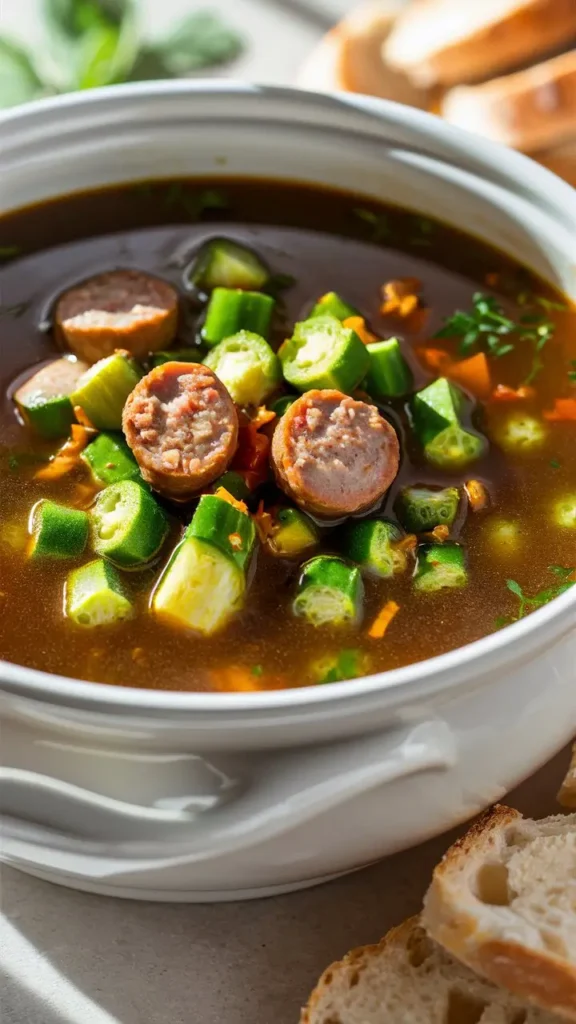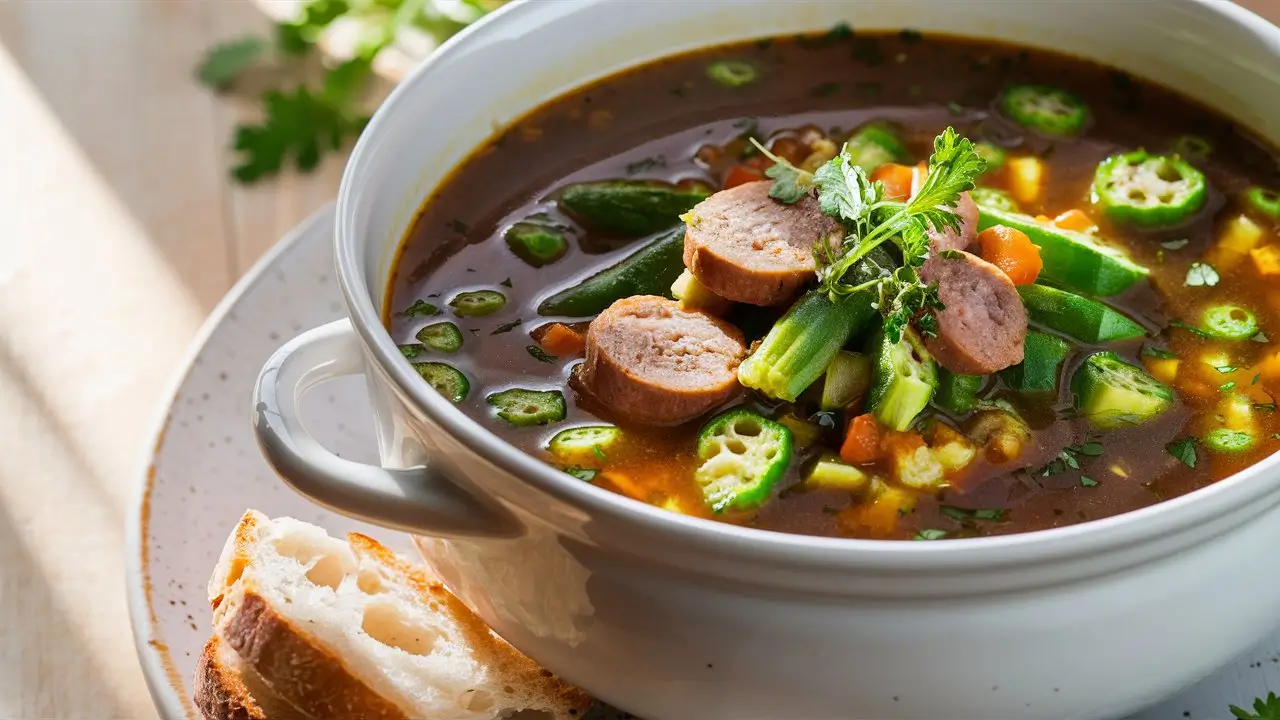Okra soup is a rich, flavorful, and comforting dish popular in many cultures across Africa, the Caribbean, and the American South. Known for its thick, stew-like texture and bold flavors, okra soup is deeply rooted in tradition and brings a delightful combination of vegetables, spices, and protein to your bowl. Whether you’re new to this dish or grew up enjoying it, okra soup is satisfying, nourishing, and incredibly versatile.
Why You Will Love This Recipe
-
Packed with Flavor: Bold spices, savory broth, and earthy okra make this soup deeply flavorful.
-
Nutritious and Wholesome: Rich in fiber, vitamins, and protein—perfect for a balanced meal.
-
Highly Adaptable: You can make it with beef, seafood, chicken, or vegetarian-style.
-
Comforting and Filling: A thick, stew-like soup that warms you from the inside out.
What is Okra Soup?
Okra soup is a thick, savory soup made primarily from okra, a green vegetable known for its natural thickening properties when cooked. Depending on the region, okra soup can include a variety of meats like beef, goat, or fish, and seasonings such as onions, tomatoes, crayfish, and palm oil. It’s often enjoyed with swallows (like fufu, pounded yam, or eba) in West Africa or served over rice in the American South.
Ingredients List
Here’s a basic overview of what you’ll need. Ingredients can vary based on the version you’re making (African-style, Creole, or Southern U.S.).
Base Ingredients:
-
1 lb (450 g) fresh okra, chopped (or 3 cups frozen sliced okra)
-
2 tablespoons palm oil or vegetable oil
-
1 medium onion, chopped
-
3 cloves garlic, minced
-
1 inch fresh ginger, grated
-
2–3 tomatoes, blended or chopped (or 1 cup canned tomatoes)
-
6 cups beef, chicken, or vegetable broth
-
Salt and black pepper, to taste
Optional Proteins:
-
1 lb beef, goat, or chicken (cut into bite-sized pieces)
-
Smoked fish or stockfish (for flavor depth)
-
Shrimp or crayfish (for West African or Creole versions)
Seasonings and Additions:
-
1 teaspoon ground crayfish (optional but traditional in Nigerian versions)
-
1 teaspoon cayenne or chili powder (adjust for heat)
-
Seasoning cubes (e.g., Maggi, Knorr) if desired
-
Spinach, kale, or ugu (fluted pumpkin leaves) for extra greens
Timing & Servings
-
Prep Time: 15–20 minutes
-
Cook Time: 40–60 minutes (depending on meat)
-
Total Time: 1 hour – 1 hour 20 minutes
-
Servings: 4 to 6 servings
Step-by-Step Instructions for Okra Soup
Step 1: Prepare Your Protein
If using beef, goat, or chicken, season lightly with salt and pepper. Boil or sear until mostly cooked through. Reserve the cooking liquid as part of your broth.
Step 2: Sauté Aromatics
In a large pot, heat palm oil over medium heat. Add chopped onions and sauté until translucent. Add garlic and ginger, and cook for another minute.
Step 3: Add Tomatoes and Cook Down
Stir in the blended or chopped tomatoes. Cook for 10–15 minutes, stirring often, until the tomatoes are no longer sour and most of the liquid has evaporated.
Step 4: Add Broth and Protein
Pour in the broth (including reserved liquid from meat if available). Add your pre-cooked beef, fish, or shrimp. Simmer for 10 minutes to allow flavors to meld.
Step 5: Add Okra
Add chopped or sliced okra to the soup. Stir well to distribute evenly. Let it simmer for another 10–15 minutes. Stir frequently to release okra’s natural thickener.
Step 6: Adjust Seasoning
Add crayfish, seasoning cubes, chili powder, and adjust salt and pepper to taste. Let everything cook together for 5–10 minutes more.
Step 7: Add Greens and Finish
If using spinach, kale, or ugu, stir it in during the last 5 minutes of cooking. Let the greens wilt and blend into the soup. Turn off the heat and let sit for a few minutes before serving.

Choosing the Right Okra
Fresh okra is ideal for the best texture and taste. Look for small to medium-sized pods that are firm and bright green.
Can You Use Frozen Okra?
Yes, frozen okra is a great time-saver. Choose pre-sliced okra for convenience. There’s no need to thaw—it can be added directly to the soup.
Tips for Making the Best Okra Soup
-
Don’t overcook the okra: Overcooked okra loses its bright color and becomes too mushy.
-
Balance the slime: Stirring continuously helps break down the slime. Acidic ingredients like tomatoes also reduce sliminess.
-
Use smoked or dried proteins for extra depth—especially in traditional African recipes.
-
Let the soup rest: Just a few minutes off the heat allows flavors to settle and deepen.
Variations by Region
Nigerian Okra Soup
Often includes palm oil, crayfish, dried fish, and is served with fufu. Meat or seafood are common, and leafy greens like ugu (pumpkin leaves) are often added.
Ghanaian Okro Soup
Can be lighter with more vegetables. Banku or kenkey is a common accompaniment. Includes tomatoes, meat, and fish.
Southern U.S. Okra Soup
A tomato-based dish often served with rice and made with chicken or sausage. Similar to gumbo but without a roux.
Caribbean Okra Soup
May include coconut milk, thyme, and scotch bonnet for heat. Popular in Jamaica and Trinidad.
Serving Suggestions
Okra soup is typically served hot with one of the following:
-
Fufu (cassava, yam, or plantain-based dough)
-
Eba (garri, made from cassava flakes)
-
Pounded yam or amala
-
Steamed rice (common in Southern U.S. and Caribbean)
-
Boiled plantains or yams as side dishes
It’s best enjoyed with your hands if served with fufu, as is traditional in many African households.
Make-Ahead and Storage Tips
Make-Ahead
-
You can prepare the broth, meat, or even the full soup a day ahead.
-
Flavors deepen after resting, so next-day soup is often even better.
Storage
-
Store in airtight containers in the fridge for up to 4 days.
-
Reheat over medium-low heat, adding a little water if too thick.
Freezing
-
Okra soup freezes well for up to 2 months.
-
Thaw in the fridge overnight and reheat gently on the stove.
Nutritional Overview (Per Serving – Approximate)
-
Calories: 350–500 (varies based on protein and oil used)
-
Protein: 20–30g
-
Carbohydrates: 15–25g
-
Fiber: 5–8g
-
Fat: 15–25g
-
Sodium: Depends on broth and seasoning cubes
Okra is rich in vitamin C, folate, and antioxidants, making this soup as healthy as it is filling.
FAQs
What does okra soup taste like?
It’s savory, earthy, and slightly grassy from the okra. When well-seasoned, it has deep umami notes and rich flavors from the protein and spices.
Can I make okra soup vegan?
Yes! Use vegetable broth, skip the meat, and add mushrooms, lentils, or tofu for substance.
How do I reduce the slime?
Add acidic ingredients like tomatoes or lemon juice, and stir frequently while cooking.
Can I make it in a slow cooker?
Yes. Cook meat first, then combine ingredients in the slow cooker and cook on low for 6–8 hours. Add okra and greens in the last 30 minutes.
Can kids eat okra soup?
Absolutely. Adjust the spice level and ensure meat is soft and bones are removed for safety.
Conclusion
Okra soup is a celebration of bold, wholesome ingredients and rich cultural heritage. Whether you prefer the West African version with palm oil and fufu or the Southern U.S. variation served with rice, this dish is comforting, deeply satisfying, and perfect for sharing. With just a few affordable ingredients, you can bring warmth, nutrition, and tradition to your table.
